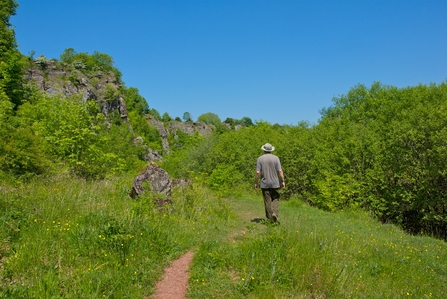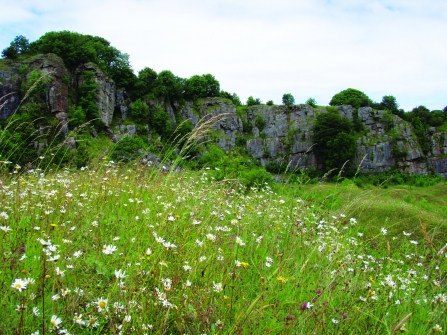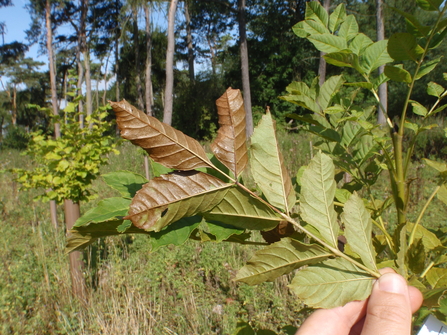
Clints Quarry Nature Reserve will be closed temporarily while essential maintenance work is carried out in the woodlands © John Morrison

Clints Quarry Nature Reserve will be closed temporarily while essential maintenance work is carried out in the woodlands © John Morrison
We are about to undertake management of woodlands at Clints Quarry Nature Reserve near Egremont, in response to ash dieback, a disease of ash trees which is now prevalent throughout the UK.
Only ash trees that are unsafe or pose a risk to public safety will be removed. The work will take place between Monday 6 and Friday 10 February. Clints Quarry Nature Reserve and its access road will be closed for the five-day period, to ensure public safety.
Clints Quarry, a popular local site for walkers, is a wildlife oasis on the edge of the Egremont. It has been left to nature for many years, but prior to this lies a long history of industry. Once quarried for agricultural lime, the Carboniferous limestone rock was used in the local steel-making industry until quarrying finally ceased in 1930. Today, the quarry is home to an abundance of wildflowers, birds and insects that bring the spoil heaps, pools and quarry face to life.
There are also woodlands at Clints Quarry, where the ash tree management will take place. We will do some replanting of native trees at the nature reserve in the coming years.
Joe Murphy, Head of Reserves at Cumbria Wildlife Trust said: “We manage a number of ash woodlands and ash is a significant part of many of our nature reserves. Sadly, some of our nature reserves will be drastically affected by the disease but we will do our utmost to ensure the best outcomes for wildlife during these difficult times.”

Clints Quarry has a rich industrial history and is home to an abundance of wildflowers and grasses, as well as woodland © Cumbria Wildlife Trust
Joe explained how our woodlands, including Clints Quarry, will be managed: “We will keep dead and dying trees wherever we can. Deadwood is a wonderful resource for wildlife and fuels woodland ecosystems. Up to 40% of woodland species depend on deadwood at some stage of their life, including many birds, mammals, fungi, plants and insects.
“We’ll only fell ash trees because of the disease when there is a risk to public safety. In some situations, where there is a public safety imperative, we may need to fell ash with no or very little sign of disease.
Joe said: “By law, the owner of land where a tree stands is responsible for the health and safety of those who could be affected by that tree. We’ve already started to take down the most dangerous trees, those that threaten busy roads, homes or other important infrastructure. Next, we intend to tackle some of our busiest footpaths and more minor roads.
There is some cause for optimism though, as Joe explained: “The loss of ash from our nature reserves may give us the chance to restructure our woodlands and encourage other species to grow. While we hope some natural regeneration will be possible, we may introduce new and different species where this will improve the habitat for wildlife.”
“We’ll keep any ash trees that appear to show a resistance to ash dieback. Once these disease-tolerant trees are recognised and looked after, we should be able to restock woodlands and the wider landscape with ash.”
Crown decline is one of the symptoms of ash dieback © Barnaby Wylder, Forestry England
It’s predicted that 80% of ash trees in the UK will be affected by ash dieback and that the disease will change our woodlands and the wider tree-scape forever.
Ash dieback is caused by a fungal pathogen, Hymenoscyphus fraxineus. The fungus that causes ash dieback originated in eastern Asia where the native ash species are tolerant to it. Although affected by it, they're able to stop the disease before it enters the woody parts of the tree. Our native ash, Fraxinus excelsior, doesn’t have such protection and, as recent history across mainland Europe has shown, the fungus can have a devastating effect.
When infected with ash dieback, the crowns of trees can become very brittle and branches start to shed, even in quite benign conditions. Ash dieback-diseased trees can also become rotten at the base, even where no, or very little, dieback is present in the crown. These trees are a risk to people and property, and also present very real problems when they need to be felled.
Signs of ash dieback include:

Foliage of an ash dieback tree © Barnably Wylder - Forestry England